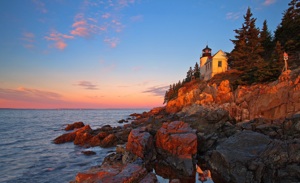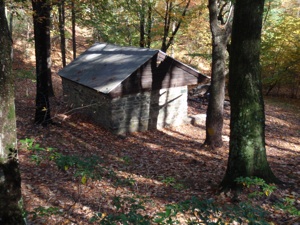It’s hard to argue that Acadia, the Blue Ridge Parkway, the Great Smokies, and Shenandoah don’t represent the cream of what the National Park Service offers in Eastern America.
There are a lot of great experiences in these top East Coast national parks, but for the truly discriminating explorer, the friends groups for these parks have awesome best-kept-secret suggestions. When we put together our Essential Friends magazine to honor these organizations and inspire their supporters, we asked to hear those rarefied recommendations.
With August only half over and the entire autumn out ahead—here are some great visitor ideas from your friends—the essential friends of some of the East’s best national parks.
Acadia National Park, From the Friends of Acadia—
Leave the crowds and head to Isle au Haut, a tiny (12.7 square miles) island south of Mount Desert Island that showcases the peaceful, remote side of Acadia. Here you’ll find a 5-site campground and a few bed-and-breakfast inns where you can end a day of hiking through northern forests, exploring cobblestone beaches, or kayaking. Bring your bike—there are no car ferries—and pedal to Duck Harbor, Eastern Head, and Western Head.
If you stay on Mount Desert Island, a visit to Acadia wouldn’t be complete without a brunch of jam-smeared popovers and tea at the Jordan Pond House. Or skip brunch and plan on a lobster dinner. Build your appetite by cruising the vehicle-free carriage roads on bikes, with stops in the art galleries of in the villages of Seal Harbor and Northeast Harbor. A stroll through the park’s Wild Gardens of Acadia at Sieur de Monts Spring will familiarize you with some of the more than 850 plant species found in Acadia.

Take off to Isle au Haut to get a big step away from the most popular parts of Acadia National Park.
Blue Ridge Parkway, From the Blue Ridge Parkway Foundation—
Talk about getting away from it all. The vast realm of the Southern Appalachians is an enigma to many. The Parkway orients you to the region—while simultaneously obscuring your regular reality with day-after-day immersion in relaxing scenery and historic insight. The ultimate trip tip: Travel the entire Parkway from end-to-end. Give it a week!
Get out of your car and hike some trails. See interpreters planting long-farmed fields. Watch grain being ground in a grist mill. Pause to hear the soul-stirring multicultural sounds of America’s roots music. Bring your children and grandchildren, attend ranger-led programs and hike on a TRACKTrail.
Hop off the road and marvel at the different resort regions along the way—including hip travel hotspots like Asheville and the lofty Boone area. Stay in nationally significant accommodations that are Parkway Plus partners. Great dining, even wineries, will inspire toasts to growing refinement in “Appalachia.”
Then share your story with the Foundation—your End-to-Ender Rewards package features a certificate suitable for framing, a RIDE pin, decals and bumper stickers.
Great Smoky Mountains National Park, From the Friends of Great Smoky Mountains National Park—
Visit the truly “quiet side” of the Smokies with a peaceful drive from Gatlinburg to Big and Little Cataloochee valleys, two idyllic settings that retain vestiges of their homesteaded days.
From Gatlinburg, take Tennessee 73 towards the Cosby Campground, and then jump on Tennessee 32. This narrow, treelined, gravel route forces you to relax and enjoy the scenery while leading you from Tennessee into North Carolina without the hectic pace of an interstate.
Both of these beautiful valleys once were thriving settlements. Big Cataloochee was one of the largest and most prosperous settlements in the area now occupied by the national park. In 1910 some 1,200 people lived in this lovely mountain valley framed by mountains climbing to 6,000 feet. Most made their living by farming, including commercial apple growing, but an early tourism industry developed in Cataloochee with some families boarding fishermen and other tourists who wished to vacation in the mountains. Today you’ll see two churches and several homes and outbuildings that are left in the valleys. The setting is great for picnics or wetting a line, and in fall this is the place to see the park’s elk.
Shenandoah, From the Shenandoah National Park Trust—
Spend a night in the backcountry—but not in a tent (unless you want!).

Though not a PATC cabin, many have this wooded setting. Kurt Repanshek photo.
The Potomac Appalachian Trail Club operates six primitive cabins in the park and the public can rent them. Don’t expect lux, but the outdoor aficionado who settles into these historic structures will have a truly unique hike-in cabin experience.
They’re popular (troll now for fall openings), but with advance planning you can spend a rustic week not too far from your car.
You’ll need to carry in your own provisions to the rustic huts, use an outhouse, and bring your water from a nearby stream, but many of the walks aren’t lengthy (a few tenths of a mile away in some cases). The stone hut of Range View Cabin has been open since 1933 and is less than a mile from parking. Pocosin Cabin is just 0.2 mile from your car. That makes it easy to resupply yourself with great food and even some luxuries. Some PATC cabins were built the Civilian Conservation Corps or were even the homes of early settlers.
A stay in a PATC cabin gives you the chance to really see how early residents of the area lived before the park. And they’re great preparation for a gourmet meal or overnight stay at Skyland Lodge when you hike back out!
Make the Leap
Not everyone will find their way to these less-sampled experiences in great East Coast national parks. But you might. And when you're done, you can thank your friends—the folks who step up and support these national treasures. National Parks Traveler hopes you'll click the links above and join them.


 Support Essential Coverage of Essential Places
Support Essential Coverage of Essential Places






